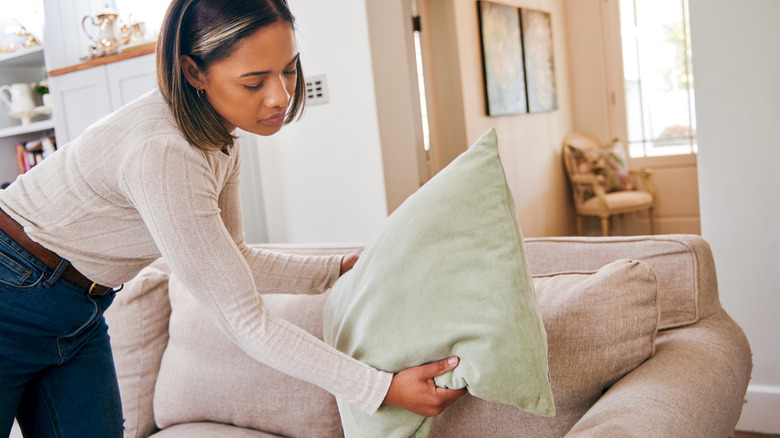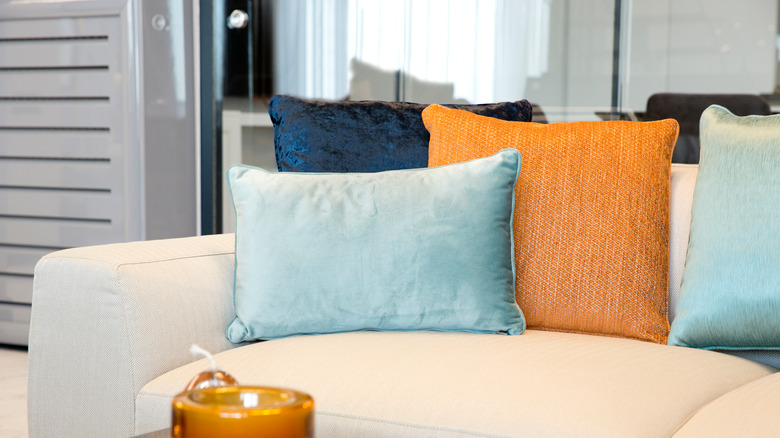Here's How Often You Should Be Cleaning Your Throw Pillows
If you wish to transform your space instantly, there's nothing as cost-effective as throw pillows for adding a touch of color and style. However, these living room mainstays are also known for collecting dust, dirt, allergens, and even stinky odors. So, the question arises: How often should you be cleaning them? As a general rule of thumb, giving throw pillows a thorough cleaning every 3 to 6 months should be fine. However, you must also consider the type of fabric, how often they're used, and other factors.
Some fabrics used to make throw pillows include cotton, burlap, silk, satin, and synthetic materials like polyester. Natural fibers like cotton or burlap require regular care with a monthly gentle warm-water machine wash. For throw pillows without removable covers, handwashing is recommended to ensure they keep their shape. If you spot any stains, pre-treat them with a mild detergent before washing them and then air-dry for optimal results. For delicate silk and satin, some tender love and care every two months or so may be necessary. Clean satin pillows with a gentle cold machine wash and then line dry. Silk ones may be washed by hand in cold water with mild detergent. Avoid wringing them out and let them air dry on a flat surface. Synthetic fabrics like polyester are generally low-maintenance and can be tumble-dried on low using a mild detergent every two months. However, heavily used throw pillows may need to be cleaned more often.
The importance of regular cleaning
Regularly cleaning your throw pillows isn't just about aesthetics; it also has a vital impact on your health and the longevity of your pillows. If allergies affect you or someone in your home, weekly vacuuming with a fabric attachment can significantly reduce symptoms. This is because dust mites, pollen, and other allergens can become trapped in the fibers. Washing the pillow covers every two weeks or following the fabric-specific guidelines can also help keep allergens at bay.
For pet owners with furry friends who love snuggling up on their pillows, fur, dander, and odors can be a concern. Depending on the fabric, washing these pillows weekly or bi-weekly may be necessary. Doing so can help make your home smell fresh and clean, especially if your pets are allowed on furniture. Even without pets or allergy concerns, oils from our skin, food stains, or the occasional spill can happen. Additionally, throw pillows can become breeding grounds for mold and mildew when left in humid environments. Regular cleaning, proper drying, and the occasional airing out can prevent these issues.
Tips for effective cleaning
Maintaining the cleanliness of your throw pillows is not just about the frequency of cleaning but also about the method. Always check care labels, as manufacturers often include essential instructions for cleaning and care. That said, minor stains usually don't require a trip to the washing machine, so feel free to spot clean whenever possible. A damp cloth and mild detergent can keep your pillows looking their best. Further, using removable, washable pillow covers can extend the life of your throw pillows and reduce the need for frequent washing. These are also an efficient way to refresh your décor without the hassle of buying new pillows.
Note that different fabrics may require specific types of detergent; for instance, wool and silk usually call for mild soap. As such, be sure to follow fabric care guidelines to avoid damage. Let your pillows dry thoroughly after washing to prevent mold and mildew. Use the tumble dry setting for synthetic fabrics and air dry for more delicate materials. Doing this will help eliminate odors and refresh the fabric. If you're storing throw pillows, ensure they're clean and dry before putting them away. It's also a good idea to use breathable bags and keep them in a cool, dry place. All it takes is a little care and attention to maintain the beauty and comfort of your throw pillows.


